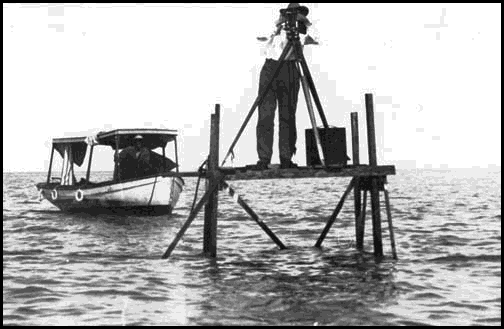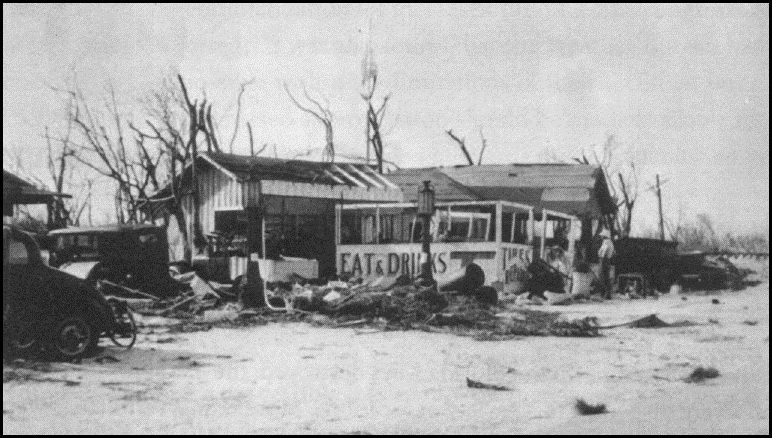
Florida's Great
Ocean Railway
Building the Key West Extension
Dan Gallagher
(Pineapple Press)

There are all sorts of addictions out there, and I am not necessarily talking drinks or drugs. Some of us are addicted to old railroads, others to hurricanes (their history, the effect on people). Some are nuts about islands, and oceans, and islands in and around oceans. Some are fascinated by old boats. For those who are afflicted by all of these, Florida's Great Ocean Railway will be a treat. It's even like a good novel: we know that it will end in disaster and tragedy.The "Key West Extension" was the brainchild of Henry Morrison Flagler, who grew rich, indeed superrich, on the idea of Florida as a dream vacation and living spot. Before 1900, only madmen and rednecks ventured into that state, if for no other reason than it was suicide: mosquitoes thrived in its moist swamps and backcountry dumps, and with mosquitoes came yellow fever, dengue, malaria, and a host of other baleful illnesses.
But public health and medicine and sanitation techniques born of the Spanish-American War made it possible to safeguard the public from the most vicious of these ailments ... and Flagler and other developers set the American Dream in motion in communities like Ormond Beach, Palm Beach, Daytona Beach, Miami, and Key West. The health problems were tamed: now all that remained was to get the middle class down there and living or visiting (and spending). This was accomplished by Flagler's railway complex all the way down the Florida coast.
The ultimate part of his dream was a link from Miami to Key West. Flagler smelled even further riches by shipping goods and people from Key West to Havana and from there to the Panama Canal. It was a dream of a transportation monopoly that only the superrich could put into practice. As friend and partner to John D. Rockefeller, Flagler had the wherewithal to do it.
Gallagher compares the construction of the Key West Extension to the building of the Panama Canal. Well, hardly. Although Flagler's railroad went twice as far as the canal, it was (almost) level, did not entail the leveling of whole mountains, digging huge trenches, and fighting with beesties even more vicious than to be found in south Florida.
Flagler's work-force never exceeded 3,500 and the death rate --- certainly the key to the difficulty of any project --- was minuscule compared to the over 27,500 who died while working on the canal across Central America. That also took twenty-three years, whereas the Overseas Railroad took only --- only --- eleven years, from 1905 - 1916.
"Much of this story is about moving earth and rock from one location to another," Gallagher writes. He computes it as almost 18 million cubic yards of earth, rock, sand, and marl. To say it was an ecological disaster is an understatement. Nesting grounds were ruined --- for birds, for sea creatures; migrating lanes for fish and fowl were destroyed, causeways and viaducts and waste dumped by construction crews permanently damaged the rich habitants of conch, crawfish, lobster, turtle, what had been one of the great repositories of American wildlife. This is not discussed in Gallagher's book.
Rather, it is a photographic history, and mostly a complimentary one at that. During the period of construction, two small hurricanes --- 1906 and 1909 --- passed over the railroad being built, the damage was slight, although over 100 workers died in the former. The big hurricane of 1935 --- the "Labor Day Hurricane" --- finished off the Extension. "According to folklore," writes Gallagher, the hurricane "destroyed the railroad and Henry Flagler's dream, and those who had once derided the roadway as 'Flagler's Folly' probably said, 'I told you so.'"
In reality, the storm did little damage. Outside of damage to tracks at Matecumbe Key,"
The rest of the railway roadbed was intact. It was rebuildable. In fact, the [Florida East Coast Railway] replaced the damaged track within a couple of months in order the bring the valuable cars and engine back to Miami ... None of the original bridges have ever been destroyed or damaged by any force other than man.
But the FEC was in receivership. Rail travel had already started to succumb to the automobile. A highway was already under construction parallel to the Extension. After the storm, the state of Florida purchased the right-of-way for $640,000, "much less than the estimated $50,000,000 that it cost to build it in the 1910s."

The tragedy? That you and I never got to ride the 150 miles in a fine old coach pulled by a coal-fired engine, hauling it across the thirty-eight great bridges and viaducts between Homestead and Key West. What a trip that would have been, eh?The velvet curtains swaying, the sea air blowing in through the coaches, the plume of smoke from old #447 blowing away in the wind, the engineer up there ahead in the engine, whistling to let the people know --- on Indian Key, Key Largo, Key Vaca, Pigeon Key, Torch Ramrod, Sugarloaf, Saddle Bunch, Islamorada, and Bahia Honda --- that we were on our way. In style.
--- Francis McKindall